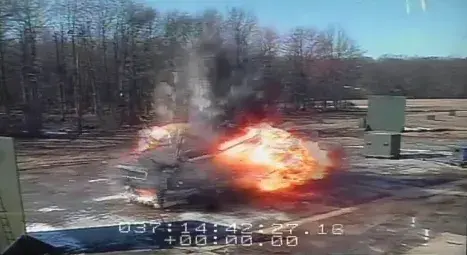Inexpensive memory chips inside new forensic cameras for mass transit protection survive a massive explosion
A few weeks ago, we told you about a test involving small, inexpensive cameras and a large bus bomb. When we left off, the explosion had tossed shreds of metal from the bus’s shell into nearby trees. Amidst the wreckage, clean-up crews had found the cameras along with their memory chips. Did they survive?
explosion had tossed shreds of metal from the bus’s shell into nearby trees. Amidst the wreckage, clean-up crews had found the cameras along with their memory chips. Did they survive?
In a word: Yes.
All 16 cameras mounted inside the bus were recovered. Of those 16, 14 memory chips were intact—an excellent record!
“Totally normal,” said U. S. Department of Homeland Security Science and Technology Directorate (S&T) program manager Stephen Dennis of the recovered images. Of the 14 cameras recovered, “every video minute on there was recovered without degradation,” Dennis said.
Sparked by interest from the Transportation Security Administration and the cities of New York, Washington, Chicago and Seattle, S&T is testing two different prototypes that it hopes will be sturdy enough to withstand bombing attacks, fires or floods, but inexpensive enough to use in places where a complete surveillance system is not workable. For both of the prototypes that industry produced, seven of eight cameras survived the massive bus explosion -- an ordeal that S&T managers consider a “representative blast test.”
Scientists and managers who took part in the test pronounced it a huge success. (Read the Snapshots initial story Lights, Camera, Ka-Boom!)
“I was very pleasantly surprised by the outcome,” said Dennis. “I did not expect these early prototype memory chips to survive at even half the rate they did.”
While so-called “rugged” memory chips currently on the market can survive heavy vibrations in industrial applications like lumber and drilling, these prototype chips are a “step beyond,” said Dennis.
The cameras on the bus were not actually recording live footage. Instead, the chips had been preloaded with videos so that engineers could cleanly compare the content and quality of images both before and after the blast.
Images recovered from working cameras would be used by law enforcement only forensically after an incident, rather than transmitting video to a third party . At $150-$200 each, outfitting a bus with cameras is a bargain compared to a surveillance system likely to cost more than $6,000.
The blast test is just one of three phases of testing that the Department is helping to carry out. In January, prior to attempting the transit bus test, engineers put 36 cameras through more controlled testing to measure the survival rate. All of them survived.
The final phase of testing will investigate how well the systems survive the kind of heat likely to be found in a burning vehicle. Engineers will bake the camera-and-chip units inside an oven at high temperatures to see if they turn to a crisp.
Development of the forensic cameras is occurring through the innovative public-private partnership known as the System Efficacy through Commercialization, Utilization, Relevance and Evaluation (SECURE) program. SECURE is based on the simple premise that the private sector is ready, willing, and able to use its own money and expertise to develop products and services more quickly than they could be developed through a public program alone. The only taxpayer money used with these forensic cameras was used for the testing. (In most SECURE projects, no taxpayer money is used at any stage.)
“Because of the SECURE program, the Department was able to test and evaluate data for a forensic camera system that could be delivered to the first responder community and others literally within a few months,” said Tom Cellucci, Department of Homeland Security chief commercialization officer.
The Department is developing plans to work with a pilot group of U.S. cities to test the reliability, performance, and maintenance requirements of cameras operating on regular bus routes and trains. Two companies – Videology Inc. of Greenville, R.I. and Visual Defence-USA, Inc. of Alexandria, Va. – are working to deliver this technology to the commercial marketplace within months, said Cellucci.
To request more information about this story, please e-mail st.snapshots@hq.dhs.gov.
